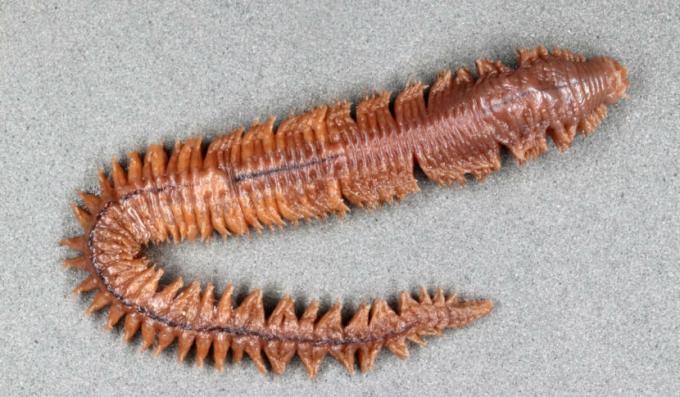You annelids (Phil Annelid) are invertebrate animals which have as a striking feature the body formed by several segments that resemble several rings joined together. These invertebrates have a body divided into three regions: prostomium, trunk and pygidium.
Annelids are found in different environments such as marine environment, fresh water and also wet soil. Following the criterion of the presence or absence of bristles, we can divide these animals into three groups:
- polychaetes,
- oligochaetes,
- hirudinous.
There are about 16,500 species of annelids, being the worms the best known representatives of this phylum.
Read too: Molluscs - phylum of soft-bodied animals
General characteristics of annelids
the annelids are invertebrate animals that present body formed by a series of segments, which resemble rings joined together. The best known representative of the annelids is the earthworm. In it, it is possible to clearly see the presence of these rings in the trunk region. See figure below.

The anterior region of the annelids is called the prostomy, this being where the brain (cerebral ganglia) is located. O stem it is the segmented part of the annelid, in which most systems are located. The final portion of the body is called the pigidium and this is where the anus is located. Annelids have a cuticle that lines and protects their body.
These animals have varied size, being possible to observe representatives with a few millimeters and others reaching several meters in length. The Australian giant earthworm, for example, can grow to an incredible three meters in length.
digestion of annelids
Annelids are animals that present extracellular digestion, owning a complete digestive system, that is, a digestive system that has a mouth and anus. In earthworms, the digestive system includes a pharynx that works by sucking food into the mouth. The food moves towards the esophagus and is then stored and moistened in the crop. In the gizzard, the food is mechanically crushed with the help of small stones and sand.
The digestion process continues towards the intestine, and the digestion residues being eliminated through the anus. THE feeding of annelids is varied and the species analyzed must be taken into account, making it possible to identify carnivores, herbivores and parasites.

Breath of annelids
The breath of the annelids varies from one species to another, since they present different ways of life. Some have cutaneous breathing, that is, through the skin, while others have branchial breathing. In polychaetes, specialized structures, called parapods, act as gills.
Read too: What are the types of ranimal breaths?
excretion of annelids
the annelids have a pair of nephridies per segment. These nephrids act as kidneys in invertebrate animals.
Circulation of annelids
O annelids circulatory system is closed, with blood flowing only inside vessels. In these animals, plasma contains dissolved hemoglobin. The hemoglobin molecule is concerned with the transport of oxygen.
annelids nervous system
The annelid nervous system is characterized by the presence of a pair of brain ganglia, also called by some authors brain, and connectives for one or two nerve cords that extend through the animal's body.
Classification of annelids
Annelids are traditionally classified according to the presence of bristles, into three groups:
- polychaetes,
- oligochaetes,
- hirudinous.
Polychaetes
They stand out for presenting a lots of bristles. Representatives of this group have appendages known as parapods, which are full of bristles and resemble oars. You parapods they act by promoting locomotion and breathing in some species.
These animals, for the most part, have separate sexes, external fertilization and indirect development, that is, the presence of larvae is observed. They are found in the marine environment.

oligochaetes
Stand out for presenting few bristles in your body. Have a digestive system adapted to a diet of decaying organic matter. Earthworms, representatives of this group, literally eat their way through the soil, ingesting it and pulling out the nutrients they need. They release what has not been digested with mucus secreted by the digestive tract, which helps in the fertility of the soil. The earthworms also act by ensuring the aeration of the land, and are therefore highly valued in the agriculture.
the oligochaetes are hermaphrodites, fertilization is crossed (sperm exchange is reciprocal) and there is no presence of larvae in their life cycle, therefore, direct development. A striking structure in the body of these animals is the clitoris, which secretes a material that forms a cocoon that surrounds the eggs. The representatives of this group are found in aquatic and terrestrial environment.
Hirudine
In the hirudine, the bristles are not observed. This group includes leeches. Some species of leeches are parasites and temporarily feed on the blood of some animals.
At leeches that have this habit have jaws that look like blades and help to cut the host's skin. They release an anesthetic substance and, as a result, the host does not feel pain while the blood is being sucked by the animal. Hirudine reproduction is similar to that of oligochaetes. This type of annelid also has clythelium.

